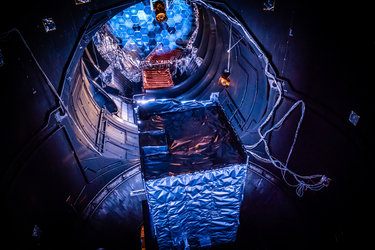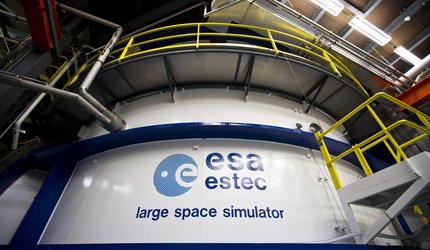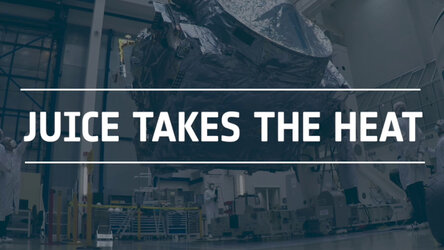Accept all cookies Accept only essential cookies See our Cookie Notice

About ESA
The European Space Agency (ESA) is Europe’s gateway to space. Its mission is to shape the development of Europe’s space capability and ensure that investment in space continues to deliver benefits to the citizens of Europe and the world.
Highlights
ESA - United space in Europe
This is ESA ESA facts Member States & Cooperating States Funding Director General Top management For Member State Delegations European vision European Space Policy ESA & EU Space Councils Responsibility & Sustainability Annual Report Calendar of meetings Corporate newsEstablishments & sites
ESA Headquarters ESA ESTEC ESA ESOC ESA ESRIN ESA EAC ESA ESAC Europe's Spaceport ESA ESEC ESA ECSAT Brussels Office Washington OfficeWorking with ESA
Business with ESA ESA Commercialisation Gateway Law at ESA Careers Cyber resilience at ESA IT at ESA Newsroom Partnerships Merchandising Licence Education Open Space Innovation Platform Integrity and Reporting Administrative Tribunal Health and SafetyMore about ESA
History ESA Historical Archives Exhibitions Publications Art & Culture ESA Merchandise Kids Diversity ESA Brand Centre ESA ChampionsLatest
Space in Member States
Find out more about space activities in our 23 Member States, and understand how ESA works together with their national agencies, institutions and organisations.
Science & Exploration
Exploring our Solar System and unlocking the secrets of the Universe
Go to topicAstronauts
Missions
Juice Euclid Webb Solar Orbiter BepiColombo Gaia ExoMars Cheops Exoplanet missions More missionsActivities
International Space Station Orion service module Gateway Concordia Caves & Pangaea BenefitsLatest
Space Safety
Protecting life and infrastructure on Earth and in orbit
Go to topicAsteroids
Asteroids and Planetary Defence Asteroid danger explained Flyeye telescope: asteroid detection Hera mission: asteroid deflection Near-Earth Object Coordination CentreSpace junk
About space debris Space debris by the numbers Space Environment Report In space refuelling, refurbishing and removingSafety from space
Clean Space ecodesign Zero Debris Technologies Space for Earth Supporting Sustainable DevelopmentLatest
Applications
Using space to benefit citizens and meet future challenges on Earth
Go to topicObserving the Earth
Observing the Earth Future EO Copernicus Meteorology Space for our climate Satellite missionsCommercialisation
ESA Commercialisation Gateway Open Space Innovation Platform Business Incubation ESA Space SolutionsLatest
Enabling & Support
Making space accessible and developing the technologies for the future
Go to topicBuilding missions
Space Engineering and Technology Test centre Laboratories Concurrent Design Facility Preparing for the future Shaping the Future Discovery and Preparation Advanced Concepts TeamSpace transportation
Space Transportation Ariane Vega Space Rider Future space transportation Boost! Europe's Spaceport Launches from Europe's Spaceport from 2012Latest

Simulating space
Thank you for liking
You have already liked this page, you can only like it once!
While most ESA personnel work from home during the COVID-19 pandemic, essential activities continue to take place on site across Agency establishments while following social distancing protocols.
In ESA’s Materials and Electrical Components Laboratory – one of a suite of labs based at the ESTEC technical centre in Noordwijk, the Netherlands – testing has continued on critical elements for several missions and projects.
For instance, the lab supported the ‘bakeout’ of the Filter Wheel Assembly for the Proba-3 formation flying mission’s main ASPIICS instrument – which will image the Sun’s ghostly surrounding atmosphere, or ‘corona’ from one satellite while another satellite blocks out the blinding solar disk.
The development of this payload was on the critical path, and the test had to be performed at very short notice just before Christmas. The successful bakeout took place with full personal protection measures in place, in order to host the customers arriving from abroad with the flight hardware.
Focusing on mission external elements, thermal endurance tests are currently underway on multilayer insulation (MLI) materials and solar cell assemblies. These tests are being carried out using the eXtreme Temperature Exposure System, XTES and XTES2 facilities – this latter facility having been procured and commissioned during the pandemic – which can reach and maintain incredibly high temperatures for long periods of time. For example, components of an MLI for the JUICE mission to Jupiter are undergoing a three-month test to address their thermal stability under mission representative conditions.
The lab is also supporting the development of new radiation-resistant coatings, by exposing them to ultraviolet and vacuum-ultraviolet light in the Synergistic Temperature Accelerated Radiation 2 (STAR2) facility).
All the environmental tests are aided by materials characterisation and analysis with state-of-the-art equipment, such as microscopic and spectroscopic analysis, thermo-optical measurements, thermal analysis and more. So the lab’s work has not halted, despite COVID-19 restrictions, but is proceeding as smoothly as possible.
-
CREDIT
ESA-Nuno Dias -
LICENCE
ESA Standard Licence

BepiColombo MPO being placed in Phenix thermal vacuu…

Juice thermal development model and the Sun simulator

Large Space Simulator

Juice takes the heat















 Germany
Germany
 Austria
Austria
 Belgium
Belgium
 Denmark
Denmark
 Spain
Spain
 Estonia
Estonia
 Finland
Finland
 France
France
 Greece
Greece
 Hungary
Hungary
 Ireland
Ireland
 Italy
Italy
 Luxembourg
Luxembourg
 Norway
Norway
 The Netherlands
The Netherlands
 Poland
Poland
 Portugal
Portugal
 Czechia
Czechia
 Romania
Romania
 United Kingdom
United Kingdom
 Slovenia
Slovenia
 Sweden
Sweden
 Switzerland
Switzerland
























